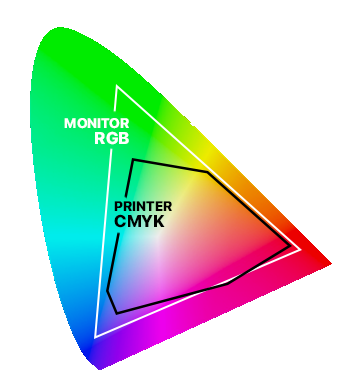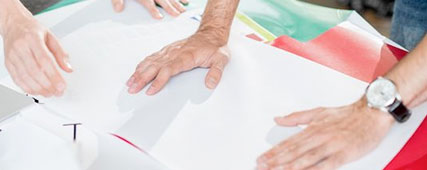Color profiles and printing: what you need to know

To ensure accurate color reproduction in print, it’s essential to provide files in CMYK. Files in RGB use a wider color space (like screens), often containing colors that can’t be reproduced faithfully in print. If we receive an RGB file, we cannot guarantee the color conversion will match your expectations.
ICC profiles, such as Fogra51 (for coated paper) and Fogra52 (for uncoated paper), help simulate the final output depending on the substrate, offering a more accurate screen preview. Their use is not mandatory; we only recommend it for advanced users. However, the only way to be truly sure of the final result is always the same: print a proof and check it under the preferred lighting conditions.
How to use them
If we apply the Fogra51 Profile (for coated paper) or the Fogra52 Profile (for uncoated paper) to our graphic design software, the colour preview we can have is even more accurate.
So, download the profiles to be installed based on the kind of paper you are going to use for printing:
How to install them
Once unzipped, take the file with the ICC extension and move it to the path indicated as follows:
Mac:
- Mac Os X (all versions): HD/Library/Colorsync/Profiles
Windows:
- Windows NT: C:/winNT/system32/color
- Windows 95, 98: C:/windows/system/color
- Windows 2000, XP, Vista, W7, W8:C:/windows/system32/spool/drivers/color
Tip: in recent Windows versions you can automatically save profiles using the right mouse button on the identified profile and then choose the option “install the profile” of the context menu.
Tip:
Restart the application so that the profile can be displayed.
Now, update the colour space of your software by choosing "Edit > Color Settings"

To learn more: Adobe’s official User Guide on how to “Install a color profile”
Check old files
Once you've set the colour profiles in your software, every time you're going to open a file formerly saved with another profile or without profile, it'll be asked to make a choice: to assign the new profile or not to activate the colour management. Obviously our suggestion is to assign a new profile to have a correct preview. In case some softwares ask you to "convert in profile", don't do it because this will change the CMYK values.PDF export preset
In order to safely export your layouts with an Adobe® software (InDesign, Illustrator or Photoshop), please use our presets, which include bleed and resolution suitable for printing.
Export ProfileIf you want to add a file with custom PDF settings, carry out one of the following operations:
- Drag the file with the extension .joboptions to the Distiller window
- In Acrobat Distiller, choose Settings > Add Adobe PDF Settings, browse until you find the copied file .joboptions, choose it and click Open.

Getting around the world of cards has never been easier. Select the filter, compare them and choose yours!